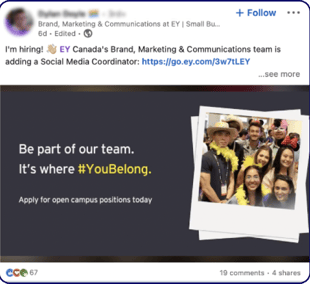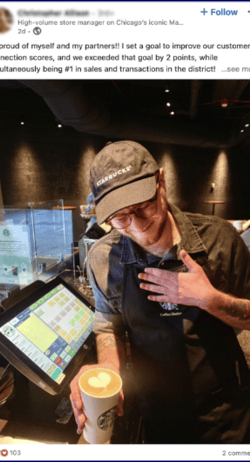
Employee advocacy: how can your business profile benefit from it?
Find out all about employee advocacy, why it is beneficial to both employees and employers, and how to launch a successful employee advocacy program in your business.
How is your business LinkedIn page related to employee advocacy? For starters, LinkedIn is the best place to promote your business and company, not only to get more clients and be present in the social media world but also to get employees and strengthen your reputation. Employee advocacy is just the tool for that. But what exactly is it, and how to incorporate it into your business strategy? Let’s discuss.
Employee advocacy refers to the promotion of a company or its products and services by its employees. It involves empowering employees to share messages and experiences about their work with their personal and professional networks, both online and offline. In this case, the best place to execute employee advocacy is on LinkedIn!
"There wasn't really a place like LinkedIn before where we could see all employee updates, like promotions, new positions, etc. That's why employee advocacy is gaining such big importance – because we have LinkedIn as a tool to promote it." Kotryna Kurt, CEO of Linkedist.
Companies can leverage their employees' networks to expand their reach and improve their brand reputation by engaging in employee advocacy. A company can decide to either have a formal or informal type of employee advocacy. Formal programs typically provide employees with guidelines, training, and tools to help them promote the company in a structured and coordinated way. On the other hand, informal programs rely on employees to promote the company on their initiative without specific guidance or support.
What is employee advocacy?
Are you looking for someone to help with your employee advocacy campaign?
Why do companies need employee advocacy?
Many types of research have been conducted to calculate the power and influence of employee advocacy on businesses, and one, in particular, found three main benefits:
Increased brand awareness and favourable views ("brand sentiment") have a beneficial effect on sales.
It enhances employee engagement, retention, and recruitment.
It supports the handling of PR difficulties and crises.
According to LinkedIn, even though just 3% of workers post content about their employer, this sharing causes a 30% rise in overall engagement for the organization. From our experience, people just like seeing other people – they find the posts more interesting and intriguing when people share their personal experiences and stories rather than a brand posting about them. It's generally easier to relate to a person than to a brand.

Steps for creating your employee advocacy program
All this information about having a well-established brand presence through employee advocacy sounds nice, but what steps to take to accomplish all the benefits? Don't worry; we prepared something for you to start your employee advocacy journey!
Choose the ambassadors.
Look beyond your marketing department – the ambassadors could be everywhere. Remember that employees who understand a company's vision in the big picture feel more invested in their work and are likelier to talk about it. Evaluate the level of trust between the ambassador and the company to ensure the experience will be credible. Lastly, don't forget to leverage the volunteers.
Implement technology.
With all the right tools and easy execution, it is much easier to carry out our goals. Curate communications to employees and give them sharable content and updates on company news and alerts anytime. Consider some fun ways to keep your employees engaged and help them. Lastly, additional tools help monitor the progress and analytics, so implement those for easy access.
Provide guidelines.
To protect the company’s reputation, avoid legal issues and educate about the technical side of content creation, it’s essential to create and share LinkedIn guidelines for employees to follow. Your policies should empower rather than restrict and focus on the following:
Technicalities – hashtags, when to post, tips & tricks, content types.
Good LinkedIn profile and post examples from the same industry.
Contacts who can help if there are any questions.
A professional code of conduct and copyright laws – if needed.
Respect towards other LinkedIn users – if needed.
Share monthly content ideas.
Your employee advocacy program needs excellent content. So every month provide your colleagues with the following:
Case studies, blog posts, events updates, downloadable assets and anything that promotes the brand.
Employee branding content such as job posts, posts about the company culture, behind-the-scene photos and videos, and anything that reveals what your company is like as an employer.
Industry insights highlighting knowledge tied to your market.
Employee-generated content from people and departments that can offer relevant information.
Have 1:1 coaching sessions.
Schedule a meeting with each ambassador and determine how they want to be positioned on the LinkedIn platform. Ask questions such as:
How do they want to be remembered by people?
What topics or industries do they want to be associated with?
What are the keywords that best describe them and their personal traits?
Voice of tone - what is it?
What is your target audience?
What is the most challenging part of the content creation process?
Provide them guidance after the call and evaluate the limitations each month.
Arrange monthly calls.
Remember to schedule the monthly calls with the groups of ambassadors to discuss the following:
A purpose of the programme.
Professional development opportunities.
Ongoing feedback and answers to their questions.
Content ideas and strategies.
How did the month go, and what can be done differently?
Recognise & reward.
Acknowledge the efforts of your employee brand advocates by:
Considering creating contests and gamifying the process with a point system and leaderboards.
Develop and offer fun rewards and devise ways to recognize participants and top achievers.
Give your top brand advocates a shout-out during meetings and via newsletters and/or your intranet.
“A good employer advocacy professional should be eager to share and gain more knowledge and discuss with other companies about good initiatives and practices. Then, when you have your do’s and don’ts, you can start your employer advocacy slowly, but have a strategy for it – market research, talent personas, etc.” - Ema Šumskytė, Employer branding specialist at Nordlocker and NordPass.
We also selected some examples of employee advocacy campaigns you can get inspired by:












LinkedIn as a No1 tool for employee advocacy
Why should you consider LinkedIn for your employee advocacy goals and strategy? First, LinkedIn is the best place to talk about business and experiences in the workplace. As the network of over 900 million users is all looking for a professional background in the platform, they are looking for industry news, relatable work stories, different practices, etc.
"On LinkedIn, you can see employee advocacy results super quickly – immediately when you post something. Brand videos, animations, and articles get good feedback, and people can see the company's culture. This may be due to the size of the company, but also the consistency of the messages we share." Line S. Aasen, Marketing and PR associate at DreamCraft Ventures.
In addition, let's not forget LinkedIn's well-established job search network. People looking to work in your company can easily access your page info and see all the posts your current employees are posting. If your employees are making posts about experiences in your company, the posts work as testimonials for your company's culture and atmosphere.
Lastly, if you are looking from a company's perspective, it already has an excellent feature for seeing your employees' posts. You can head to your page as an admin and click on "Employee's posts".


This way, you can see the latest posts by your employees performing better than others and track their results in one place.
In addition, LinkedIn has said to rule out new, additional employee advocacy tools. One is the ability to advertise your employee's posts, resulting in an even bigger audience reach and new promotion possibilities for brands.
Benefits for the employees
In addition to being a beneficial program for your company, there are many advantages for the employees who are becoming brand ambassadors. Here are the most prominent benefits we have selected:
Employees get to know the principles of strengthening one’s personal brand;
They discover the best strategy for positioning themselves and their organization on LinkedIn (other social media channels – as needed) as well as for creating content;
They learn to create attractive, engaging, and valuable content;
Employees strengthen writing, social, and communication skills through individual and group tasks.
Bottom line
Employee advocacy is a great tool to reach potential future employees, strengthen your brand’s image online and teach your workers additional skills. LinkedIn is a great place to improve your employee advocacy muscles. The platform provides you with the necessary tools, and it’s easy to track results and encourages you to keep consistency. An employee advocacy program could be a tough nut to crack, but with the correct determination and proper help, you will see growing results quickly. Best of luck with employee advocacy!



